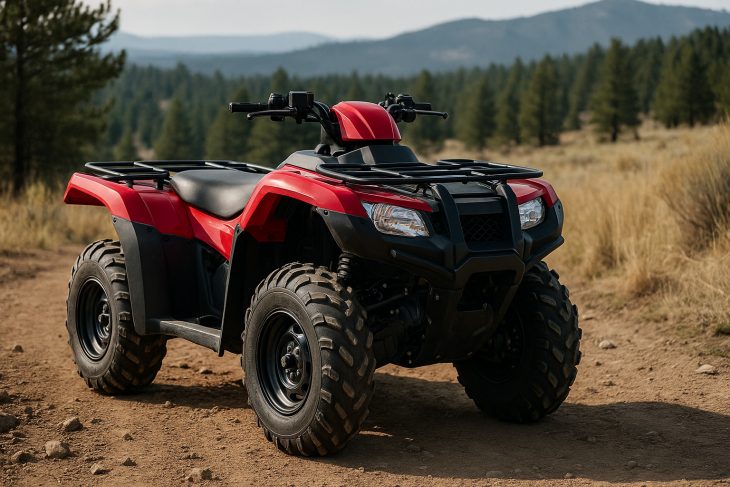
All-Terrain Vehicles (ATVs) have transformed from experimental machines to indispensable tools for work, sport, and recreation. Whether tearing across rugged trails or hauling gear through the backcountry, ATVs offer unmatched versatility. Here’s a comprehensive list of 30 facts that highlight their history, types, mechanics, safety insights, and interesting trivia.
History and Development
1. The Original Three-Wheel Design
ATVs started out with three wheels. The earliest models, like the Sperry-Rand Tricart from 1967, had no resemblance to the four-wheelers seen today.
2. Born as Amphibians
Before the trikes, ATVs referred to six-wheeled amphibious vehicles such as the Jiger, developed in 1961 for traversing both land and water.
3. Honda’s 1970 Game-Changer
The Honda US90, later named the ATC90, introduced the concept of balloon tires instead of suspension. It became the iconic face of early recreational ATVs.
4. A College Project Sparked It All
John Plessinger’s 1967 college engineering assignment aimed to create a tricycle for tough terrain. That project laid the foundation for modern ATVs.
5. Suzuki Introduced the First Quad
In 1982, Suzuki launched the QuadRunner LT125. It was the first commercially available four-wheeled ATV and featured reverse gear and five forward speeds.
6. America’s First ATV
Polaris entered the scene in 1985 with the Trailboss, the first ATV produced in the U.S., helping to grow a domestic ATV market.
7. Safety Concerns Ended Three-Wheelers
By 1988, manufacturers voluntarily stopped producing three-wheeled ATVs due to rising safety concerns flagged by U.S. regulators.
8. Pop Culture Promotion
Honda’s three-wheelers gained massive attention after appearing in Diamonds Are Forever and the Magnum, P.I. TV series.
9. Honda FourTrax 300: A Bestseller
Launched in 1988, the FourTrax 300 and its 4×4 version sold over 530,000 units in 12 years, making it the most popular ATV series in history.
Types and Uses
10. Built for Work: Utility ATVs
Utility ATVs come with large engines and racks to haul gear. They’re widely used in farming, forestry, and remote job sites.
11. Fast and Agile: Sport ATVs
Designed for trail-riding and racing, sport ATVs are lighter, quicker, and feature advanced suspension for handling jumps and tight corners.
12. The Rise of Side-by-Sides
UTVs or Side-by-Sides seat multiple passengers, use steering wheels instead of handlebars, and serve both recreational and commercial needs.
13. Kid-Friendly Models Exist
Youth ATVs are scaled down with limited speed, smaller engines, and additional safety features to accommodate younger riders.
14. Serving Military and Emergency Crews
Thanks to their maneuverability and ruggedness, ATVs are used by rescue teams and the military in hard-to-reach areas.
15. Farming’s Favorite Tool in the ’90s
By the 1990s, ATVs became standard on many farms. Their fuel efficiency and adaptability made them ideal replacements for small tractors.
Mechanics and Features
16. Engine Sizes Cover the Full Range
ATV engines start under 50cc for youth models and exceed 1,000cc in high-performance versions, tailored for heavy hauling or high-speed use.
17. Thumb Throttles Are the Standard
Instead of motorcycle-style twist throttles, ATVs use thumb-operated throttles to reduce wrist strain and improve control.
18. Four-Wheel Drive Changed Everything
The 1986 Honda FourTrax 350 4×4 was the first ATV to include four-wheel drive, significantly expanding off-road capability.
19. Suspension That Adapts
Modern ATVs feature adjustable suspension systems that let riders fine-tune shock absorption for trail, mud, sand, or track riding.
20. Packed with Electronics
Contemporary ATVs include advanced electrical systems to manage ignition, lights, digital gauges, and even onboard diagnostics.
Safety and Statistics
21. High Risk for Children
Riders under 16 account for a disproportionate number of injuries and fatalities in ATV-related incidents, especially on adult-sized machines.
22. Helmets Save Lives
A properly worn helmet reduces the chance of death by 42% and nonfatal head injuries by 64%, making it the single most effective safety measure.
23. Emergency Rooms See Thousands
In the U.S., ATV crashes result in hundreds of deaths and tens of thousands of ER visits every year, underscoring the need for safer riding practices.
24. Investigations Started in the ’80s
In 1984, the U.S. CPSC launched investigations into ATV safety, leading to the end of three-wheeled model production four years later.
25. Rollover Risk is Real
In Canada, rollovers are the leading cause of ATV-related fatalities. Poor terrain judgment and lack of safety gear often contribute.
Fun Facts and Trivia
26. Outsold Dirt Bikes
In 2012, more than 225,000 ATVs were sold in the U.S.—far exceeding the 71,500 dirt bikes sold that same year.
27. First Camo ATV
Yamaha released the Buckmaster Edition Big Bear 400 4×4 in 2000, featuring the industry’s first camouflage-patterned bodywork.
28. Racing Goes Way Back
ATVs entered the Grand National Cross Country racing series in 1980. The ATV Motocross Championship followed in 1985.
29. Fuel-Saver in the ’70s
During the fuel shortages of the 1970s, ATVs grew in popularity on farms due to their better mileage compared to tractors.
30. Suzuki’s High-Performance Breakthrough
The 1985 Suzuki LT250R QuadRacer brought high-performance features to the masses—like a liquid-cooled two-stroke engine and manual transmission.
Why These ATV Facts Matter
From their humble three-wheeled origins to high-tech machines with advanced suspension and electrical systems, ATVs have continually adapted to meet new demands. They’re more than just off-road toys—used in agriculture, military, rescue, and motorsport. Understanding their development, uses, and risks helps riders make informed decisions. Whether you’re considering your first ride or have years of trail experience, these facts highlight the machine’s versatility and significance. Safety, innovation, and purpose-built design are what keep ATVs relevant across work and recreation.
Was this page helpful?
Our commitment to delivering trustworthy and engaging content is at the heart of what we do. Each fact on our site is contributed by real users like you, bringing a wealth of diverse insights and information. To ensure the highest standards of accuracy and reliability, our dedicated editors meticulously review each submission. This process guarantees that the facts we share are not only fascinating but also credible. Trust in our commitment to quality and authenticity as you explore and learn with us.